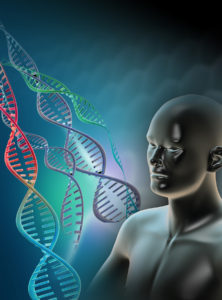 With extensive PR, the Genome Project promised rapid cures for many diseases by deciphering the genetic code for less than 2% of the human DNA involved in making proteins in a small number of people. After the Genome Project, there were almost no cures found in that code. In the decade after the project, research increasingly showed the fantastic complexity of the regulation of that tiny percentage of our DNA in a region at least ten times larger than the “genes.” (See posts on genetic complexity) It, also, showed that many differences in code exist between normal individuals. Millions of regulatory RNAs were discovered. The massive use of alternative splicing in the human brain was discovered. It, also, was found that in diseases that are based on a series of mutations, such as cancer, there are many individual variations in the mutations causing the same disease. Many diseases have large numbers of genes that are somehow related and not understood—autism, schizophrenia as examples. Also, it was found that fifty percent of the total DNA is “jumping genes” (see post) with critical effects on normal brain function and human brain evolution.
With extensive PR, the Genome Project promised rapid cures for many diseases by deciphering the genetic code for less than 2% of the human DNA involved in making proteins in a small number of people. After the Genome Project, there were almost no cures found in that code. In the decade after the project, research increasingly showed the fantastic complexity of the regulation of that tiny percentage of our DNA in a region at least ten times larger than the “genes.” (See posts on genetic complexity) It, also, showed that many differences in code exist between normal individuals. Millions of regulatory RNAs were discovered. The massive use of alternative splicing in the human brain was discovered. It, also, was found that in diseases that are based on a series of mutations, such as cancer, there are many individual variations in the mutations causing the same disease. Many diseases have large numbers of genes that are somehow related and not understood—autism, schizophrenia as examples. Also, it was found that fifty percent of the total DNA is “jumping genes” (see post) with critical effects on normal brain function and human brain evolution.
 A cautionary tale of the promise of curing disease through identifying the genes involved is found by studying Huntington’s—a devastating neurodegenerative disease with a dominant gene that has been known for twenty-three years. Dominant gene means that anyone with one copy of the gene from either mother or father gets the disease. A burning question must be asked: why is there no cure for Huntington’s a generation after identifying the gene involved.
A cautionary tale of the promise of curing disease through identifying the genes involved is found by studying Huntington’s—a devastating neurodegenerative disease with a dominant gene that has been known for twenty-three years. Dominant gene means that anyone with one copy of the gene from either mother or father gets the disease. A burning question must be asked: why is there no cure for Huntington’s a generation after identifying the gene involved.
The fantastic complexity of human DNA is just beginning to unravel. As an example, this post will describe the current knowledge about Huntington’s and why there is no cure yet.
The Huntingtin Molecule
 The gene related to Huntington’s disease, called HTT (the gene has also been referred to as HD or IT15) makes the huntingtin (Htt) protein. The version of the gene with the mutation makes the abnormal mutant (mHtt) huntingtin protein. It has been found recently that the normal version of the protein huntingtin, Htt, is a critical scaffolding molecule for many vital cellular processes (especially in neurons) including axon transport of many important molecules and organelles, critical actions related to the spindle in cell division, direction of neuronal adhesion and involvement in large protein complexes in metabolism and the primary cilium. The abnormal mutant version mHtt causes many problems and decreases the amount of the normal protein. Problems can come from too little of the normal protein or too much of the abnormal mutant version.
The gene related to Huntington’s disease, called HTT (the gene has also been referred to as HD or IT15) makes the huntingtin (Htt) protein. The version of the gene with the mutation makes the abnormal mutant (mHtt) huntingtin protein. It has been found recently that the normal version of the protein huntingtin, Htt, is a critical scaffolding molecule for many vital cellular processes (especially in neurons) including axon transport of many important molecules and organelles, critical actions related to the spindle in cell division, direction of neuronal adhesion and involvement in large protein complexes in metabolism and the primary cilium. The abnormal mutant version mHtt causes many problems and decreases the amount of the normal protein. Problems can come from too little of the normal protein or too much of the abnormal mutant version.
The complex variable shape of the proteins allows a wide range of sites to interact with all kinds of critical protein complexes. But, even more confusing is that both versions of the protein undergo extensive alterations through tags and enzymatic cutting that alters the shape of the very complex molecule and creates many different versions. These alterations provide many different normal and abnormal varieties of the protein as well as small strands that can form clumps in various places.
Mutation Produces Extra Repeats of Amino Acid Glutamine
 The mutation that causes the disease was discovered in 1993 and consists of repeating DNA code that creates an abnormal increase in one particular amino acid in one section of the protein—increased glutamine. These multiple glutamines exist near the N terminal region of the protein. Htt protein has approximately three thousand amino acids and it is repetition of the amino acids from the DNA code C-A-G (cytosine-adenine-guanine) that causes the large amount of glutamine—this stretch is called polygultamine or polyQ.
The mutation that causes the disease was discovered in 1993 and consists of repeating DNA code that creates an abnormal increase in one particular amino acid in one section of the protein—increased glutamine. These multiple glutamines exist near the N terminal region of the protein. Htt protein has approximately three thousand amino acids and it is repetition of the amino acids from the DNA code C-A-G (cytosine-adenine-guanine) that causes the large amount of glutamine—this stretch is called polygultamine or polyQ.
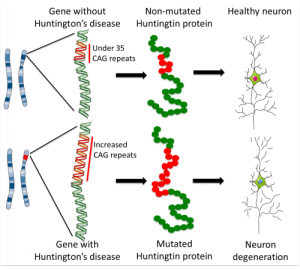 Of the two copies of Huntingtin gene from mother and father, if either is mutant the child inevitably develops the disease with some variation of the age of onset. The mutation of the protein is inherited in a dominant way, which means that approximately half of the children of those with the mutation get the devastating disease consisting of muscle weakness and abnormal movements, with cognitive and behavior problems. The movement disorder impairs coordination and leads to falls, breathing issues and many other problems. The abnormal movements are called chorea named for the dance like quality of the movements (“chorea” is related to word “choreography”). Five to ten people in 100,000 have Huntington’s disease. Specific neurons in the striatum of the brain die, which causes the symptoms. Interneurons are not usually affected.
Of the two copies of Huntingtin gene from mother and father, if either is mutant the child inevitably develops the disease with some variation of the age of onset. The mutation of the protein is inherited in a dominant way, which means that approximately half of the children of those with the mutation get the devastating disease consisting of muscle weakness and abnormal movements, with cognitive and behavior problems. The movement disorder impairs coordination and leads to falls, breathing issues and many other problems. The abnormal movements are called chorea named for the dance like quality of the movements (“chorea” is related to word “choreography”). Five to ten people in 100,000 have Huntington’s disease. Specific neurons in the striatum of the brain die, which causes the symptoms. Interneurons are not usually affected.
The problem with Huntington’s research is that the normal Htt protein occurs prominently in many places in tissues and cells throughout the body. Htt protein exists in all mammal cells, with the most in the brain. Because Htt has many complex interactions with other important molecules and systems, it has been very hard to pin down exactly what the normal and abnormal proteins do and how exactly the disease is started. Even though great progress has been made in this quest, the vast normal functions of Htt are still being discovered.
Complex Variable Shape of Htt and mHtt

The shape of the huntingin protein is determined by the amino acid sequence. When there are a large number of repeats, the shapes and functions of the protein are altered. It is, also, altered by alternative RNA splicing (see post) and by posttranslational modifications such as tags and enzyme cuts (lysis or proteolysis). Alterations occur with the expansion of a section of the gene that has repeats of the DNA code C-A-G short for nucleic bases in the DNA of cytosine-adenine-guanine. Many repeats of the CAG code create a different form of the protein with many extra glutamine amino acids. It is not yet understand exactly how these repeats increase from generation to generation.
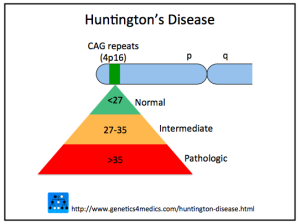 When there are 40 or more repeats, the disease is triggered. From 35 to 40 repeats some will get the disease, but not others. Below 35, the disease is not caused. The average normal person has 17 to 20 repeats of the glutamine amino acid and this is variable. The more repeats, the younger the disease starts with disease occurring in children when there are 75 repeats. Neurons connecting cortex and striatum are most affected and decrease in the size of both brain centers starts a decade before any symptoms. Other affected systems include metabolism, immune function, muscle wasting, weight loss, bone loss and heart failure. Death usually occurs 20 years after the start of the disease.
When there are 40 or more repeats, the disease is triggered. From 35 to 40 repeats some will get the disease, but not others. Below 35, the disease is not caused. The average normal person has 17 to 20 repeats of the glutamine amino acid and this is variable. The more repeats, the younger the disease starts with disease occurring in children when there are 75 repeats. Neurons connecting cortex and striatum are most affected and decrease in the size of both brain centers starts a decade before any symptoms. Other affected systems include metabolism, immune function, muscle wasting, weight loss, bone loss and heart failure. Death usually occurs 20 years after the start of the disease.
Structure of Htt
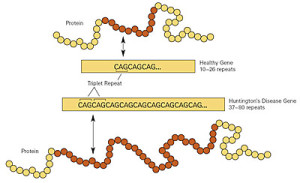 The excessive glutamines appear near the N terminal of the protein. This terminal has a section before the repeating glutamines with 17 amino acids and then a section after it with many proline amino acids, called proline rich domain or PRD. These are variable in individuals. Each of these sections have different functions for attachment to important protein complexes.
The excessive glutamines appear near the N terminal of the protein. This terminal has a section before the repeating glutamines with 17 amino acids and then a section after it with many proline amino acids, called proline rich domain or PRD. These are variable in individuals. Each of these sections have different functions for attachment to important protein complexes.
The 17 amino acids before the glutamine repeats have the form of an alpha helix that is important for the endoplasmic reticulum to hold the protein. This section of the protein is involved in signaling to get out of the nucleus and is altered by tags such as acetyl, methyl, sumoylation, ubiquitins, and phosphorylations. These tags determine where the protein will go in the cell.
Htt has Many Shapes
 New research shows that the first 17 amino acids are in an alpha helix and the glutamine repeat stretch is flexible with many different shapes, including alpha helix, a coil, and a loop. The next proline section forms a proline helix (PP), which is either kinked or straight. PP helps to determine the shape of the glutamine repeat section and may be involved in Htt forming clumps. The other amino acids from 69 to 3000 (these numbers represent the order of the amino acids starting from the N terminal) are not as well understood. This is because the trouble occurs in the first exon and most of the study has been there. The rest of this very long complex molecule is only now being studied.
New research shows that the first 17 amino acids are in an alpha helix and the glutamine repeat stretch is flexible with many different shapes, including alpha helix, a coil, and a loop. The next proline section forms a proline helix (PP), which is either kinked or straight. PP helps to determine the shape of the glutamine repeat section and may be involved in Htt forming clumps. The other amino acids from 69 to 3000 (these numbers represent the order of the amino acids starting from the N terminal) are not as well understood. This is because the trouble occurs in the first exon and most of the study has been there. The rest of this very long complex molecule is only now being studied.
Another important section is called HEAT, which repeated over the course of the molecule. (These are named for Htt, Elongation factor 3, Protein phosphatase 2A and yeast kinase TOR1). These HEAT sections form structures of rods made of helixes and are involved in intracellular transport processes through contact with other proteins. There are other transport proteins that bring material into the nucleus which have many HEAT repeats (such as importin beta with 19 repeats). The HEAT repeats are solenoid like and become a scaffold structure for many different protein complexes in the cell.
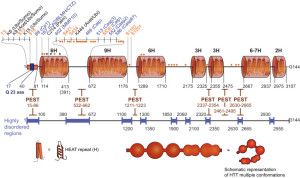 There are other sections in the middle of the protein that connect with many other proteins. One is called NES (nuclear export sequence) at position 2400 of 3000. There are other sections called PEST and some of these sections appear to be disordered. PEST stands for amino acids proline (P), glutamic acid (E), serine (S) and threonine (T). All of these variables make Htt a very versatile protein to interact with many different proteins in the cell. There have been 100 different structures discovered for the molecule. This makes in much harder to study.
There are other sections in the middle of the protein that connect with many other proteins. One is called NES (nuclear export sequence) at position 2400 of 3000. There are other sections called PEST and some of these sections appear to be disordered. PEST stands for amino acids proline (P), glutamic acid (E), serine (S) and threonine (T). All of these variables make Htt a very versatile protein to interact with many different proteins in the cell. There have been 100 different structures discovered for the molecule. This makes in much harder to study.
Alternative Splicing makes isoforms of Htt Protein
To make the Htt protein, two messenger RNAs with 67 exons are edited in variable ways. One of the two messenger RNAs has a special section that is mainly a form of Htt in the brain. Very recently, there have been found many alternative splices of Htt forming a variety of different types, called isoforms. Some of these lack exons 10,12, 29 and 46 and one has an additional exon.
Proteolysis of Htt Makes Many Different Shapes

Among the processes that occur after the formation of the protein (such as the tags), multiple enzymes called proteases cut the protein in distinct sections forming yet more shapes. PEST sections of the molecule are most involved in proteolysis. These regions are disordered, meaning variable flexible shapes.
Enzymes that cut Htt in different ways include caspases, calpin, cathepsins, and metalloproteinases. The cuts occur in normal Htt and abnormal mHtt. But, in those with Huntington’s disease there are uniquely more cuts in the molecules of the brain. Some cuts make small fragments of the glutamine repeat region that can form clusters (like amyloid and tau). These clusters enter the neuron’s nucleus where they damage the cell.
But, there are other fragments from these protein cuts (proteolysis) that are part of normal functions. Some occur near the other end of the molecule (C terminal). Some of these fragments may alter the normal functions of the molecule in interacting with important protein complexes. Fragments from the C terminal (not near the glutamine repeats) can also be toxic and cause cell death. This appears to happen in other diseases than Huntington’s.
These cuts create a very complex situation where some of the cuts help the normal function and some damage the cells. For example, a normal cut at 586 and 552 creates a fragment that is then tagged and alters the autophagosome, which is integral to getting rid of cellular waste in people without the disease.
Htt Modifications Regulate Its Function

All of the changes that occur to a protein after it is manufactured are called posttranslational modifications, including the cuts and the tags mentioned. Some of the cuts have been shown to change the toxicity of the mutant mHtt. The mHtt needs an acetyl tag to allow the autophagosome lysosome pathways to get rid of it. But, this doesn’t happen to the normal Htt Adding a phosphorus tag onto the mutant mHtt at 434 and 536 lowers toxicity from the poly glutamine section. At both 13 and 16 it lowers toxicity, but this has other normal important functions. In another place 1181, it increases axon transport in both directions and at 421 only in one direction.
These tags on Htt affect other proteins as well. Multiple different complex tags (palmitoylation) are involved in regulating placement of proteins throughout the neuron.
Htt is Everywhere
 A major problem in this research is that various kinds of Htt are found in all human tissues and cells in different layers of regulation and protein complexes. As well as the places where the brain is damaged in Huntington’s, Htt appears to be very active in many parts of the interneurons, the cortex, hippocampus and cerebellum. There is much more Htt in the brain than other organs. But, in many tissues where there is mainly one type, the detection of total activity is altered and there might be more than previously thought. For example epithelial cells have a lot of activity and nearby cells do not appear to.
A major problem in this research is that various kinds of Htt are found in all human tissues and cells in different layers of regulation and protein complexes. As well as the places where the brain is damaged in Huntington’s, Htt appears to be very active in many parts of the interneurons, the cortex, hippocampus and cerebellum. There is much more Htt in the brain than other organs. But, in many tissues where there is mainly one type, the detection of total activity is altered and there might be more than previously thought. For example epithelial cells have a lot of activity and nearby cells do not appear to.
The timing of the effects is another problem. Huntington’s has some changes that already occur in the infant and then others that progress many years later. Where exactly it appears and operates is not really clear, but it is very widespread making it hard to study.
Htt Interacts with Many Important Proteins
 Early on, 40 different proteins were found to interact with Htt, many proteins that were first discovered in this research. Associated proteins are critical in transcription, RNA splicing, endocytosis (see previous post on synaptic vesicles), axon transport in the neuron and metabolic regulation. Changes in the glutamine repeat section alters these relationships and could be relevant to the disease. Later, there were 230 different proteins that were found to interact with Htt.
Early on, 40 different proteins were found to interact with Htt, many proteins that were first discovered in this research. Associated proteins are critical in transcription, RNA splicing, endocytosis (see previous post on synaptic vesicles), axon transport in the neuron and metabolic regulation. Changes in the glutamine repeat section alters these relationships and could be relevant to the disease. Later, there were 230 different proteins that were found to interact with Htt.
Recently, in the striatum cells (where the damage occurs), there are 350 different interacting proteins, with 200 of them increased in mutant mHtt and 150 in normal Htt. Another study shows 363 with specific mutant interactions in 350.
These interactions with protein complexes are part of major cellular pathways, but they are not in all the important pathways. Most appear to be involved in the cytoskeleton scaffolding (like tau in microtubules), in endocytosis (synaptic vesicles), transport along the axon microtubules, neuronal adhesion, metabolism, the manufacture of proteins, and RNA processes. The related proteins are, also, involved in the cascades that are triggered by signals (cellular communication).
Consistent with all of these studies is that Htt is a scaffolding molecule for many purposes (as tau is for the one purpose of microtubule transport). Being large and stable is important in scaffolding and Htt can form the hub that connects many other proteins with specific functions. It is involved in assembling the complexes and taking them apart, such as with motors dynein and dynactin. When Htt forms a stable hub it closes its shape, not allowing interactions with the C terminal or other sections that can change its shape.
Normal Htt Functions: Vesicles
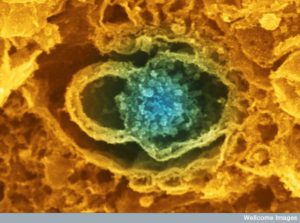 A previous post showed the fantastically complex processes that allow vesicles to be formed, filled with critical information, transmitted and then recycled. Htt along with the Huntingtin-associated protein or HAP1, interacts with the motors dynein and kinesin (see axon transport post). Htt is critical in the transport of organelles like mitochondria along the axon and dendrites. It is involved in preparing the synaptic vesicles used to transmit neurotransmitters at the synapse. It interacts the transport of with SNARE vesicles, (see post on synaptic vesicles), lysosomes and vesicles carrying BDNF, GABA and the precursor molecule for amyloid. The abnormal mHtt has a role in disturbing transport of mitochondria.
A previous post showed the fantastically complex processes that allow vesicles to be formed, filled with critical information, transmitted and then recycled. Htt along with the Huntingtin-associated protein or HAP1, interacts with the motors dynein and kinesin (see axon transport post). Htt is critical in the transport of organelles like mitochondria along the axon and dendrites. It is involved in preparing the synaptic vesicles used to transmit neurotransmitters at the synapse. It interacts the transport of with SNARE vesicles, (see post on synaptic vesicles), lysosomes and vesicles carrying BDNF, GABA and the precursor molecule for amyloid. The abnormal mHtt has a role in disturbing transport of mitochondria.
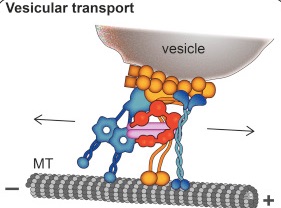
Htt increases the speed of the transport by connecting energy machinery to the motors along the microtubules. It can coordinate the direction of the transport.
Htt generally works with endocytosis interacting with many proteins such as those related to the clathrin mechanisms. Htt is involved in the invagination of the membrane and building the clathrin coat. There are a vast number of protein complexes involved in each type of endocytosis including the recycling. Current research finds Htt critical in many of these mechanisms.
Htt has other mechanisms involved in regulating vesicles. Another complex with Htt is pulled into an endosome that is forming. Hit interacts strongly with actin stabilizing the structure and decreasing its movement. Htt increases the actin and decreases microtubules. This activity increases function in the vesicle transport system of the Golgi.
Normal Htt Function: Cell Division
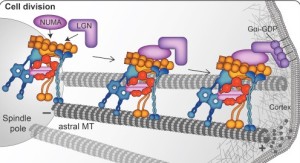
The spindle, which orchestrates cell division, has been called the most complex machine in nature. Htt is part of the spindle poles for mitosis. When neuron stem cells divide, Htt connects the poles of the spindles with the dynein and kinesin motors as well as the microtubules that radiate from the spindle. This is an extremely complex system with many other critical parts. Htt stabilizes the pulling forces and spindle orientation in mitosis.
Normal Htt Function: Cellular Cilia
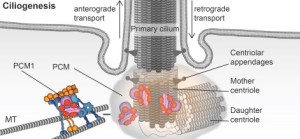
A previous post described the primary cilium as the critical brain of all cells. It is both a sensor to the outside world and decision maker (see post on primary cilium).Htt is in the base of the cilia in neurons, photoreceptors and other critical brain cells. It, again, works with the motors such as dynein and dynactin to move proteins in the clia. Without working Htt the cilia don’t work. Without working Htt there are no cilia.
Normal Htt Function: Autophagy
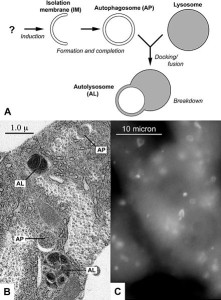
Autophagy is the very complex and critical process that takes apart unnecessary molecules and sends them to the lysosome to be either recycled or discarded. The glutamine repeats of Htt increases the autophagy pathway abnormally by inhibiting the mTOR system (see post on mTOR). Htt affects the ability of the autophagosomes to load material for disposal. Therefore, the cell cannot get rid of debris.
This alteration of autophagy occurs through multiple mechanisms. It affects the transport of the autophagosome vesicles on the microtubule transport. It affects the Golgi, which is the center of vesicle formation. Specific regions of the Htt molecule near the C end interact with critical kinase enzymes. It alters the link between cargoes and the transport microtubules and decreases the identification of cargoes. Htt binds to a protein that recognizes particular tags on molecules that define their destination.
Normal Htt Function: Transcribing Messenger RNA From DNA
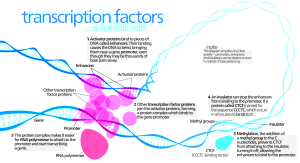
In Huntington’s patients there are problems with basic genetic mechanisms. Transcription of DNA code into messenger RNA is the critical first step in making proteins. There are many ways that Htt interacts with the DNA machinery.
Htt is mostly in the cytoplasm but does exist in the nucleus as well. Glutamine repeats are part of transcription factors and regulators. Htt binds to many transcription factors that are crucial to start and stop the process of making messenger RNA (activators and repressors). It, also, binds to nuclear receptors including vitamin D and thyroid hormone receptors that, also, affect increasing and decreasing effects. Htt binds to the critical p53 regulating molecule that is critical for cell division, cancer formation, apoptosis, DNA repair and stress responses (see post on Inverse Relation of Cancer and Brain Disease). Htt interacts with special genes that are essential for creation and maintenance of neurons. Normal Htt affects the gene that makes the critical brain factor BDNF that is essential to make new neurons in the hippocampus.
The mechanism of these genetic effects appear to be creating the scaffold for transcription and for the three dimensional structures of chromatin. Htt is involved in transporting factors into the nucleus.
Normal Htt Function: Cell Survival

Normal Htt protects cells even from the toxicity of abnormal mHtt. Without Htt there is more cell death. With abnormal mHtt, there is dramatic cell loss in the brain, up to 30% of volume. One mechanism of Htt helping cell survival involves countering programmed cell death (apoptosis). Another mechanism involves making sure that regions of the brain receive factors like BDNF. Htt increases vesicles that transport BDNF both forwards from the cortex to the striatum and backwards. Because Htt is so critical in this junction, it this region that first deteriorates with abnormal Htt.
Other Htt Function in Normal Physiology
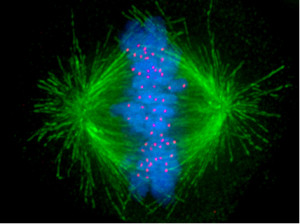 The Htt gene is necessary for fetal development and especially the nervous system. It is critical for the stem cells that make the neurons in the striatum, cortex and thalamus. The primary early mechanisms are its vital role with cell division through association with the mitotic spindle. It affects the ability of neurons to migrate to their positions in the brain. The mechanism appears to be through affecting cilia. Hit, also, affects choroid cells and affects cerebrospinal fluid and causes hydrocephalus.
The Htt gene is necessary for fetal development and especially the nervous system. It is critical for the stem cells that make the neurons in the striatum, cortex and thalamus. The primary early mechanisms are its vital role with cell division through association with the mitotic spindle. It affects the ability of neurons to migrate to their positions in the brain. The mechanism appears to be through affecting cilia. Hit, also, affects choroid cells and affects cerebrospinal fluid and causes hydrocephalus.
To make things even more complex, Htt also has widespread affects in other organs. It affects sperm, mammary glands, general metabolism, heart, liver, kidneys and lungs.
Cause and Treatment of Huntington’s Disease
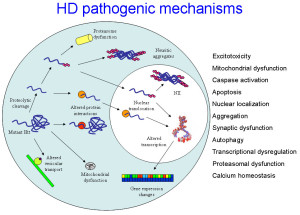 Normal Htt has many different shapes because of isoforms from alternative RNA splicing, many different tags placed in various sections of the protein and enzyme cuts that form a variety of different versions. These same alterations occur with the abnormal mHtt forming a variety of shapes and clumps. All of these different variations in the protein affect the shape and many places in the diverse flexible protein that interact with a wide variety of critical protein complexes in vital cellular processes. This makes a firm determination very difficult.
Normal Htt has many different shapes because of isoforms from alternative RNA splicing, many different tags placed in various sections of the protein and enzyme cuts that form a variety of different versions. These same alterations occur with the abnormal mHtt forming a variety of shapes and clumps. All of these different variations in the protein affect the shape and many places in the diverse flexible protein that interact with a wide variety of critical protein complexes in vital cellular processes. This makes a firm determination very difficult.
There are many possible ways that Htt and mutant mHTT might cause the disease. Fragments of the glutamine repeats form clumps that travel into the nucleus causing death of neurons by stopping the manufacture of proteins. It is confusing that Htt can both cause the toxicity and work against it at the same time and the result may depend upon where this occurs in the cell and the stage of the disease. Htt can cause more fragments to be created by protease cutting that affect the organelles of the cell such as the endoplasmic reticulum, decrease of autophagy and decrease of axon transport along the microtubules of critical material. It can cause calcium dys-regulation and increase of glutamate that also kills neurons.
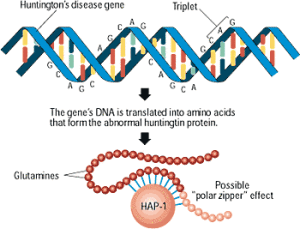 The mutant mHtt changes all of the interactions with protein complexes. There is gradually more abnormal and less normal Htt, which damages neurons by having less BDNF. mHtt causes the cilium to be too long or too short and neither are functional. It causes empty autophagosomes further damaging the cells since they cannot identify and disassemble debris.
The mutant mHtt changes all of the interactions with protein complexes. There is gradually more abnormal and less normal Htt, which damages neurons by having less BDNF. mHtt causes the cilium to be too long or too short and neither are functional. It causes empty autophagosomes further damaging the cells since they cannot identify and disassemble debris.
It is not yet clear whether the damage of Huntington’s disease is from loss of the normal functions of Htt or increase of the abnormal functions of mHtt. With one normal and one abnormal gene there is half good and half bad Htt. It has not been possible to identify the effects of this in the fetus.
These questions are significant if the approach of decreasing the amount of abnormal Htt will be an effective therapy. It is not clear if increasing normal Htt and decreasing mutant mHtt would be an effective therapy. It is also not clear if this is possible. There are great difficulties distinguishing all of the variations in the normal and abnormal Htt. Loss of normal Htt has been shown to increase some cancers such as metastasis of breast cancer.
Why is There No Cure For Huntington’s?

The gene was identified in 1993 and there is still no treatment to slow or stop the disease. This is partially because of the vast complexity of the interactions of Htt with many vital protein complexes. Also, the regulation of these processes by microRNA is just being researched. The many different ways that the protein is altered (post translational modifications) through tags and enzymes are just being described. The effects of these alterations are very complex and are related to the large number of normal and abnormal functions.
It is possible that too little normal Htt or too much abnormal mHtt does the damage. It is possible that most of the damage is from particular enzyme cuts of abnormal mHtt forming particular clumps, in which case treatment could include altering enzymes.
Huntington’s is a cautionary tale for those who think diseases will be rapidly cured by generating the DNA code.